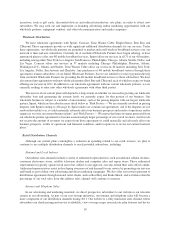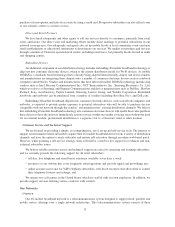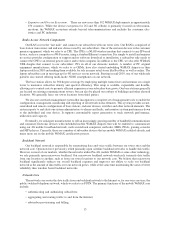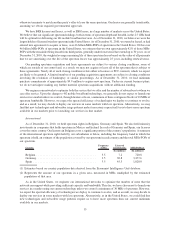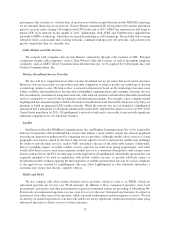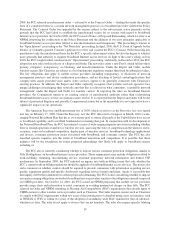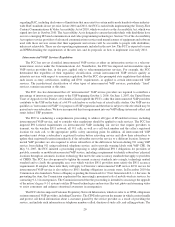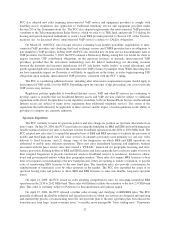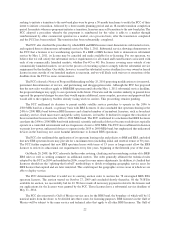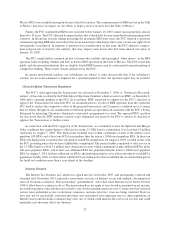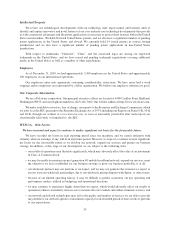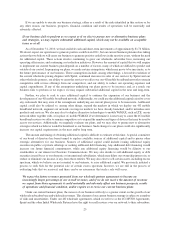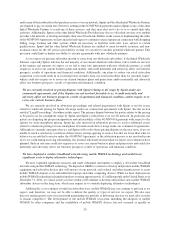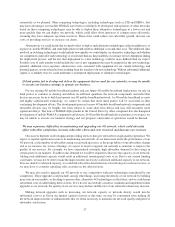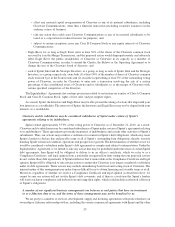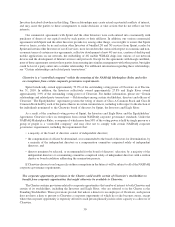Clearwire 2010 Annual Report Download - page 25
Download and view the complete annual report
Please find page 25 of the 2010 Clearwire annual report below. You can navigate through the pages in the report by either clicking on the pages listed below, or by using the keyword search tool below to find specific information within the annual report.regarding HAC, including disclosures of limitations that may exist for certain multi-mode handsets where industry-
wide HAC standards do not yet exist. In late 2010 and 2011, the FCC is tasked with implementing the Twenty-First
Century Communications & Video Accessibility Act of 2010, which we refer to as the Accessibility Act, which was
signed into law in October 2010. The Accessibility Act is designed to ensure that individuals with disabilities have
access to emerging IP-based communication and video programming technologies. Section 716 of the Accessibility
Act requires service providers of advanced communications services and manufacturers of equipment and software
used with those services ensure that their equipment and services will be accessible to people with disabilities,
unless not achievable. There are also reporting requirements included in the new law. The FCC is expected to issue
an NPRM detailing the requirements of the new law, and its proposals on how to implement it in early 2011.
Interconnected VOIP Services Regulation
The FCC has not yet classified interconnected VoIP service as either an information service or a telecom-
munications service under the Communications Act. Nonetheless, the FCC has imposed certain mandates upon
VoIP service providers that, in the past, applied only to telecommunications services. For example, the FCC
determined that regardless of their regulatory classification, certain interconnected VoIP services qualify as
interstate services with respect to economic regulation. But the FCC also preempted state regulations that address
such issues as entry certification, tariffing and E911 requirements, as applied to certain interconnected VoIP
services. The jurisdictional classification of other types of interconnected VoIP services, particularly “fixed”
services, remains uncertain at this time.
The FCC also has determined that all “interconnected” VoIP service providers are required to contribute a
percentage of interstate gross revenues to the USF beginning October 1, 2006. On June 1, 2007, the United States
Court of Appeals for the District of Columbia Circuit upheld the FCC’s order that interconnected VoIP providers
contribute to the USF on the basis of a 64.9% safe harbor or on the basis of actual traffic studies. Our VoIP service
qualifies as “interconnected VoIP” for purposes of USF regulation and therefore is subject to this fee which may be
passed on to our subscribers. We have incorporated this fee requirement into our VoIP billing system and collect and
remit federal USF payments.
The FCC is conducting a comprehensive proceeding to address all types of IP-enabled services, including
interconnected VoIP service, and to consider what regulations should be applied to such services. The FCC has
imposed E911-related requirements on interconnected VoIP, including our service that require providers to
transmit, via the wireline E911 network, all 911 calls, as well as a call-back number and the caller’s registered
location for each call, to the appropriate public safety answering point. In addition, all interconnected VoIP
providers must obtain a subscriber’s registered location before activating service and allow their subscribers to
update their registered location immediately if the subscriber moves the service to a different location. Intercon-
nected VoIP providers are also required to advise subscribers of the differences between dialing 911 using VoIP
service from dialing 911 using traditional telephone service, and to provide warning labels with VoIP CPE. On
May 31, 2007, the FCC initiated a proceeding proposing to adopt additional E911 obligations for providers of
portable, nomadic or mobile interconnected VoIP service, including a requirement to identify subscribers’ physical
locations through an automatic location technology that meets the same accuracy standards that apply to providers
of CMRS. The FCC has also proposed to tighten the current accuracy standards into a single, technology neutral
standard and to clarify the geographic area over which wireless E911 providers must satisfy the E911 accuracy
requirements. If adopted, these rules likely will apply to Clearwire’s interconnected VoIP service. E911 service for
interconnected VoIP service is also subject to E911 funding obligations in certain states. In December 2010 the
Commission also launched a Notice of Inquiry regarding the framework for “Next Generation E-9-1-1 Services. In
presenting the item, the Commission emphasized the increasingly prominent role of mobile wireless services for
contacting 9-1-1 in emergencies. The Commission noted that the proceeding is intended to encourage the upgrade
of the nation’s legacy 9-1-1 system to utilize IP-based technologies and services like text, photo and streaming video
to assist consumers and enhance situational awareness in emergencies.
The FCC also has imposed Customer Proprietary Network Information, which we refer to as CPNI, obligations
on interconnected VoIP providers, including Clearwire. The CPNI rules govern the manner in which carriers handle
and protect call detail information about a customer gained by the service provider as a result of providing the
service, and include such information as telephone numbers called, duration of such calls, and calling patterns. The
20


